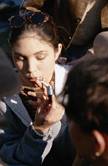
WEDNESDAY, Sept. 30, 2015 (HealthDay News) — Bubblegum, cotton candy, chocolate: Just a few of the tempting flavors often added to tobacco being consumed by American children and teens.
Now, an analysis of the 2014 National Youth Tobacco Survey finds that seven in 10 middle and high school students who used tobacco in the previous month have used at least one flavored tobacco product.
“Flavored tobacco products are enticing a new generation of America’s youth into nicotine addiction, condemning many of them to tobacco-related disease and early death,” Dr. Tom Frieden, director of the U.S. Centers for Disease Control and Prevention, said in a CDC news release.
One expert agreed that more should be done to curb uptake of these products.
“Although flavorings in cigarettes, except for menthol, have been banned by the U.S. Family Smoking Prevention and Tobacco Control Act for the last several years, over 7,000 flavors that entice adolescents remain in many other tobacco products,” said Pat Folan, director of the Center for Tobacco Control at North Shore-LIJ Health System in Great Neck, N.Y.
Folan said that while most kids understand that smoking is a deadly habit, “the attractive flavors in products, such as e-cigarettes, hookah, cigars and smokeless tobacco, have led young people to perceive them as less harmful.”
The new study was led by Linda Neff of the CDC’s Office on Smoking and Health. Her team looked at the survey data and found that about 63 percent of the students who used tobacco products — nearly 1.6 million children and teens — had used a flavored electronic cigarette.
In addition, among the students who used tobacco, nearly 61 percent (about one million) had used flavored water pipe tobacco, about 63 percent (910,000) had smoked a flavored cigar, nearly 59 percent (690,000) had used flavored smokeless tobacco, nearly 54 percent (900,000) had puffed on menthol cigarettes, and about 42 percent (120,000) had used flavored tobacco in pipes, the findings showed.
High school students were more likely than middle school students to use flavored tobacco, the study found. About 18 percent of all high school students said they used at least one flavored tobacco product in the previous 30 days, compared with just under 6 percent who said they used only non-flavored tobacco products.
Rates were similar for boys and girls, according to the report.
“Given the popularity of flavored tobacco products among youth, it’s critical to address flavorings in all tobacco products,” Brian King, deputy director for research translation in CDC’s Office on Smoking and Health, said in the news release. “Efforts to curb the availability and use of flavored tobacco products could help reduce overall rates of tobacco use among our nation’s youth,” he added.
For example, some cities have restricted or limited the sales of flavored tobacco products, the CDC news release pointed out.
Folan agrees with such measures.
“The CDC study demonstrates the need for more regulation of not only traditional cigarettes, but all tobacco products,” she said. “Prohibiting flavors in tobacco products will decrease the probability that they will be used by young people.”
Another expert said the very young are especially vulnerable to picking up and sticking with the smoking habit.
“A previous study showed that adolescents who smoke from age 13 to 17 are the least likely group to quit smoking,” said Dr. Len Horovitz, a pulmonary specialist at Lenox Hill Hospital in New York City.
“The fact that flavoring nicotine entices this group to enjoy nicotine — for flavor and for the drug effect — is worrisome evidence that a group of lifelong smokers is being created,” he said. “E-cigarettes are a transition to smoking for too many as it is, and adding flavor may ‘seal the deal.'”
The study was published in the Oct. 2 issue of the CDC’s Morbidity and Mortality Weekly Report.
More information
The American Cancer Society has more about child and teen tobacco use.
Copyright © 2025 HealthDay. All rights reserved.

